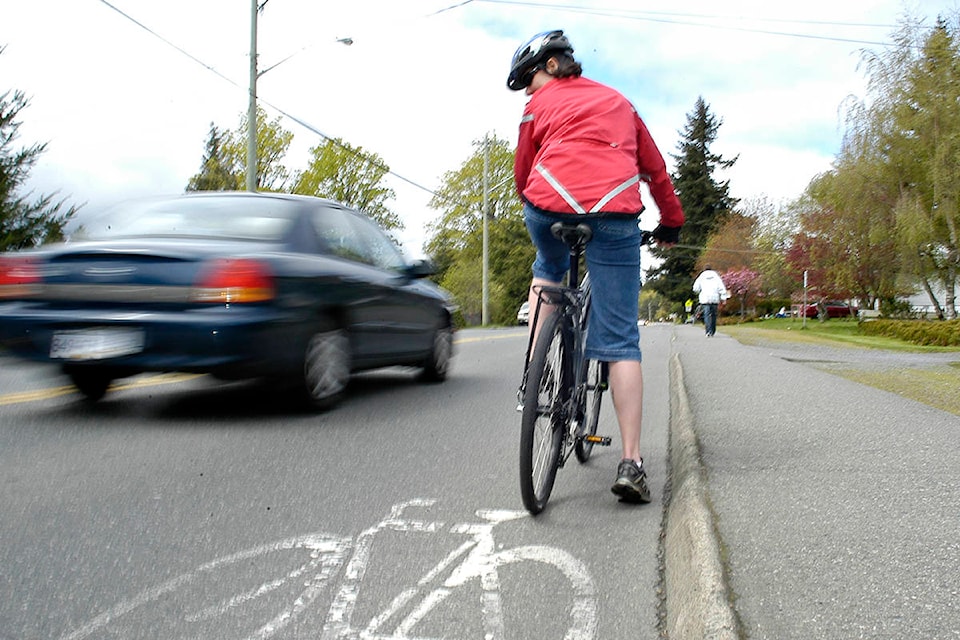Nanaimo’s citizens are always on the move and so transportation issues are always on their minds.
Cycling and walkability were some of the topics residents and councillors were keen to talk about at an e-town hall meeting this week.
The special city council meeting, held May 23 at the Vancouver Island Conference Centre, was scheduled in order to create different options for citizen engagement around council’s strategic priorities. Residents asked questions in person and via e-mail and social media, and several questions pertained to various modes of transportation in the city.
Council alluded to the upcoming active and sustainable transportation master plan, which the city will begin to work on in 2020, and talked about ways to encourage cycle and walking trips and public transit use.
“This council is very amenable to changing the culture of transportation in Nanaimo,” said Coun. Erin Hemmens, adding that citizens should continue to ask for active transportation infrastructure, even in parts of town where it might be cost-prohibitive.
Mayor Leonard Krog said if the city were to put bike lanes everywhere they’ve been requested, property tax increases would be “a lot more than five per cent” and there would be construction chaos.
“It is a very expensive proposition and made very difficult when you are trying to implement these within an existing city that might not necessarily have what we would hold to be our standard of infrastructure today, especially for pedestrians and cyclists,” said Coun. Tyler Brown.
Coun. Don Bonner said he wants to look into the idea of having development cost charges possibly pay for sidewalks or bike lanes in other parts of the city. He said Nanaimo wasn’t built with bikes in mind.
“In order to create the bike lanes that we will need in the future, we’re going to have to start making roads thinner or less lanes in them. If we wanted to put a bike lane down Bowen Road, which I would like to see … we’d have to lose at least one lane on Bowen Road which probably wouldn’t go over very well with many people out here,” he said. “So we’re going to have to do some compromises.”
Hemmens said even if Nanaimo wasn’t built for bikes, it is bike-able, with the E&N and the Parkway Trail acting as “two spines” and more networks planned around the downtown and on Metral Drive.
“These are projects that are going to connect this network so we are essentially building a city that works for bikes, but it’s incremental, it takes time…” she said. “Connectivity is a bit of an issue, granted, but I don’t want people to use ‘this city wasn’t built for bikes’ as an excuse not to bike.”
During ensuing discussion around other modes of active transportation, Brown mentioned that sidewalks don’t make a city walkable unless they connect places that are also pedestrian-friendly. He added that the same principles apply to public transit – more service hours help, but buses need to stop places where users don’t then need a car.
“The best transportation plan is a good land-use plan and those things take time,” Brown said. “It’s making sure that you’re developing complete neighbourhoods. Whether they are more urban in nature or more suburban in nature, they can be walkable.”
He said the city can guide land use through zoning and the official community plan and mentioned the upcoming OCP review.
Coun. Ian Thorpe suggested active transportation is always a consideration for city projects.
“Our city staff, when they are involved in planning and re-doing of streets or areas or subdivisions, are very, very aware and concerned about improving our transportation options for citizens,” he said. “So it’s not just a case of replacing a roadway, it’s now automatically a case that staff will look at how can we improve pedestrian access, improve access for cyclists and all forms of transportation?”
RELATED: B.C. reveals plan to cut greenhouse gas emissions by 60% by 2040
READ ALSO: How to go about getting a sidewalk
editor@nanaimobulletin.com
Like us on Facebook and follow us on Twitter
